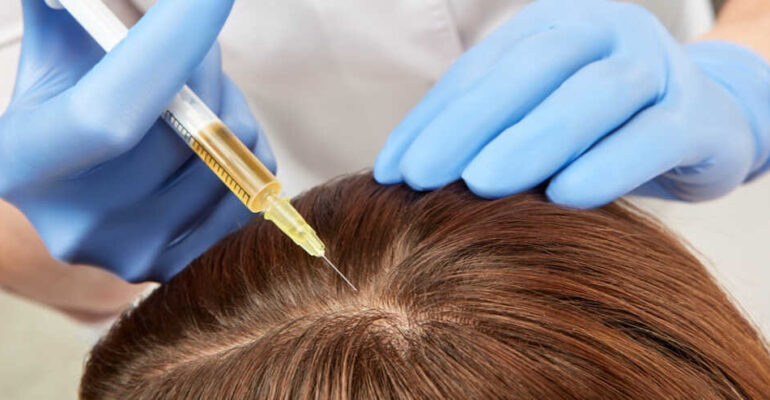PRP Therapy for Hair Loss: A Dermatologist’s Guide
August 27, 2021 2025-04-25 11:08PRP Therapy for Hair Loss: A Dermatologist’s Guide
As an Amazon associate, Dermatocare earns from valid purchase made by clicking on the affiliate links in this blog.

PRP Therapy for Hair Loss: A Dermatologist’s Guide
Hair loss—whether due to androgenetic alopecia, stress, or nutritional deficiencies—can be distressing. Among the evolving treatment options, Platelet-Rich Plasma (PRP) therapy has gained popularity due to its regenerative potential and minimal invasiveness.
In this article, we explore what PRP is, how it is performed, its indications, efficacy, safety, and the expected outcomes for patients with hair loss.
What is PRP Therapy?
Platelet-Rich Plasma (PRP) is an autologous biological product derived from the patient’s own blood. It contains a high concentration of platelets, which are rich in growth factors such as platelet-derived growth factor (PDGF), vascular endothelial growth factor (VEGF), transforming growth factor (TGF), and epidermal growth factor (EGF).
These growth factors play a crucial role in:
- Prolonging the anagen (growth) phase of hair follicles
- Stimulating dormant follicles
- Improving scalp circulation
- Enhancing collagen synthesis and cellular repair
How is PRP Done?
The procedure is performed in a dermatology clinic and involves the following steps:
Step 1: Blood Collection
A small amount of blood (usually 10–20 ml) is drawn from the patient’s arm.
Step 2: Centrifugation
The collected blood is spun in a centrifuge to separate the platelet-rich plasma from red blood cells and other components.
Step 3: PRP Extraction
The concentrated plasma rich in growth factors is extracted using sterile techniques.
Step 4: Scalp Preparation
The scalp is cleaned and sometimes numbed with a topical or local anesthetic for comfort.
Step 5: PRP Injection
The PRP is injected in micro-doses into the thinning or balding areas of the scalp using fine needles. Microneedling may be performed before or after to enhance absorption.
The entire session typically lasts 45–60 minutes.
How Many Sessions Are Needed?
The standard PRP protocol involves 3–4 sessions spaced 4–6 weeks apart, followed by maintenance sessions every 4–6 months, depending on the response and progression of hair loss.
Response may begin to appear after the second or third session, with visible improvements in hair texture, thickness, and density typically seen at 3–6 months.
What Are the Uses of PRP in Hair Loss?
PRP is indicated for several types of alopecia, including:
1. Androgenetic Alopecia (Pattern Hair Loss)
- Most effective in early stages
- Works well in both men and women
- Delays progression and enhances hair volume
2. Telogen Effluvium
- Supports faster recovery by reactivating follicles
- Useful in chronic or stress-induced shedding
3. Alopecia Areata (Adjunctive Role)
- Used alongside corticosteroids or immunotherapies
- May reduce inflammation and promote follicular regrowth
4. Post-Hair Transplantation
- Enhances graft survival and accelerates healing
What Are the Side Effects of PRP Therapy?
PRP is generally safe because it uses the patient’s own blood. However, mild side effects may occur:
- Scalp tenderness or discomfort at injection sites
- Mild swelling or bruising (usually resolves in 2–3 days)
- Redness or itching at the treated area
- Temporary headache or heaviness
In rare cases, there may be infection or allergic reactions if aseptic precautions are not followed.
What is the Response to PRP Therapy?
Clinical studies and patient reports show that 70–80% of individuals with early-stage hair loss experience noticeable improvements in:
- Hair density and thickness
- Reduced hair shedding
- Improved hair texture
- Delayed progression of hair thinning
The response is best in patients under 40 years of age with recent-onset hair loss and active follicles. PRP is less effective in advanced baldness where hair follicles are permanently lost.
Conclusion
PRP therapy offers a safe, minimally invasive, and effective option for hair restoration, particularly in early to moderate hair loss. While not a cure for baldness, it can significantly delay progression, enhance outcomes of medical treatments, and improve quality of life for many patients.
Dermatologist’s Tip:
PRP works best when combined with a comprehensive hair regrowth regime including topical minoxidil, nutritional support, and lifestyle optimization.
To know whether PRP is suitable for your type of hair loss and to build a customized recovery plan, use the Dermatocare Regime Finder Tool or consult your dermatologist for one-on-one evaluation.
ROUTINE FINDER
Get free dermatologist-recommended regime by choosing your skin or concerns.

FACE

HAIRS

CHILD

BODY




